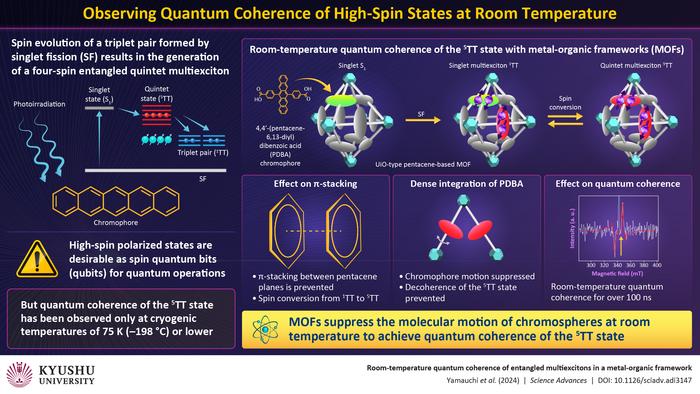Fukuoka, Japan—In a study published in Science Advances, a group of researchers led by Associate Professor Nobuhiro Yanai from Kyushu University’s Faculty of Engineering, in collaboration with Associate Professor Kiyoshi Miyata from Kyushu University and Professor Yasuhiro Kobori of Kobe University, reports that they have achieved quantum coherence at room temperature: the ability of a quantum system to maintain a well-defined state over time without getting affected by surrounding disturbances

Credit: Nobuhiro Yanai
Fukuoka, Japan—In a study published in Science Advances, a group of researchers led by Associate Professor Nobuhiro Yanai from Kyushu University’s Faculty of Engineering, in collaboration with Associate Professor Kiyoshi Miyata from Kyushu University and Professor Yasuhiro Kobori of Kobe University, reports that they have achieved quantum coherence at room temperature: the ability of a quantum system to maintain a well-defined state over time without getting affected by surrounding disturbances
This breakthrough was made possible by embedding a chromophore, a dye molecule that absorbs light and emits color, in a metal-organic framework, or MOF, a nanoporous crystalline material composed of metal ions and organic ligands.
Their findings mark a crucial advancement for quantum computing and sensing technologies. While quantum computing is positioned as the next major advancement of computing technology, quantum sensing is a sensing technology that utilizes the quantum mechanical properties of qubits (quantum analogs of bits in classical computing that can exist in a superposition of 0 and 1).
Various systems can be employed to implement qubits, with one approach being the utilization of intrinsic spin—a quantum property related to a particle’s magnetic moment—of an electron. Electrons have two spin states: spin up and spin down. Qubits based on spin can exist in a combination of these states and can be “entangled,” allowing the state of one qubit to be inferred from another.
By leveraging the extremely sensitive nature of a quantum entangled state to environmental noise, quantum sensing technology is expected to enable sensing with higher resolution and sensitivity compared to traditional techniques. However, so far, it has been challenging to entangle four electrons and make them respond to external molecules, that is, achieve quantum sensing using a nanoporous MOF.
Notably, chromophores can be used to excite electrons with desirable electron spins at room temperatures through a process called singlet fission. However, at room temperature causes the quantum information stored in qubits to lose quantum superposition and entanglement. As a result, it is usually only possible to achieve quantum coherence at liquid nitrogen level temperatures.
To suppress the molecular motion and achieve room-temperature quantum coherence, the researchers introduced a chromophore based on pentacene (polycyclic aromatic hydrocarbon consisting of five linearly fused benzene rings) in a UiO-type MOF. “The MOF in this work is a unique system that can densely accumulate chromophores. Additionally, the nanopores inside the crystal enable the chromophore to rotate, but at a very restrained angle,” says Yanai.
The MOF structure facilitated enough motion in the pentacene units to allow the electrons to transition from the triplet state to a quintet state, while also sufficiently suppressing motion at room temperature to maintain quantum coherence of the quintet multiexciton state. Upon photoexciting electrons with microwave pulses, the researchers could observe the quantum coherence of the state for over 100 nanoseconds at room temperature. “This is the first room-temperature quantum coherence of entangled quintets,” remarks an excited Kobori.
While the coherence was observed only for nanoseconds, the findings will pave the way for designing materials for the generation of multiple qubits at room temperatures. “It will be possible to generate quintet multiexciton state qubits more efficiently in the future by searching for guest molecules that can induce more such suppressed motions and by developing suitable MOF structures,” speculates Yanai. “This can open doors to room-temperature molecular quantum computing based on multiple quantum gate control and quantum sensing of various target compounds.”
###
For more information about this research, see “Room-temperature quantum coherence of entangled multiexcitons in a metal-organic framework,” Akio Yamauchi, Kentaro Tanaka, Masaaki Fuki, Saiya Fujiwara, Nobuo Kimizuka, Tomohiro Ryu, Masaki Saigo, Ken Onda, Ryota Kusumoto, Nami Ueno, Harumi Sato, Yasuhiro Kobori, Kiyoshi Miyata, and Nobuhiro Yanai, Science Advances, http://doi.org/10.1126/sciadv.adi3147
About Kyushu University
Kyushu University is one of Japan’s leading research-oriented institutes of higher education since its founding in 1911. Home to around 19,000 students and 8,000 faculty and staff, Kyushu U’s world-class research centers cover a wide range of study areas and research fields, from the humanities and arts to engineering and medical sciences. Its multiple campuses—including one of the largest in Japan—are located around Fukuoka City, a coastal metropolis on the southwestern Japanese island of Kyushu that is frequently ranked among the world’s most livable cities and historically known as Japan’s gateway to Asia. Through its Vision 2030, Kyushu U will ‘Drive Social Change with Integrative Knowledge.’ Its synergistic application of knowledge will encompass all of academia and solve issues in society while innovating new systems for a better future.
Journal
Science Advances
DOI
10.1126/sciadv.adi3147
Method of Research
Experimental study
Subject of Research
Not applicable
Article Title
Room-temperature quantum coherence of entangled multiexcitons in a metal-organic framework
Article Publication Date
3-Jan-2024
COI Statement
The authors declare that they have no competing interests.




